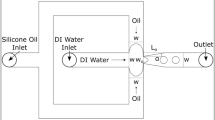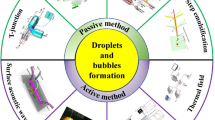Abstract
This paper deals with a specific aspect of non-miscible liquid–liquid systems in microfluidic. For Chemical Engineering applications, the main constraints of functioning lie in the droplets velocity and frequency. Furthermore, the material used and the composition of the fluids is often imposed by the chemistry of the system (material resistance and fluids composition) and there is no possibility of adding other compounds (e.g., surfactants). A technique under evaluation is presented: by using secondary channels and pumps, it is possible to increase or decrease, at will, the droplets velocity after they have been generated. Some experimental results are presented and discussed, including the possible limits of such an approach.
Similar content being viewed by others
Avoid common mistakes on your manuscript.
1 Introduction
The problem of controlling the flow patterns formed by two phase flows in microchannels has attracted a lot of attention. The parameters influencing these patterns are numerous; it involves the nature of the two fluids (including possible use of surfactants), the geometry and configuration of the injection, as well as the chip surface characteristics, etc. Indeed, the physics in such systems is largely dominated by interfacial effects. All this makes the problem difficult to describe in a simple way.
The first way of influencing the flow regimes (and the droplets sizes), is to vary the inlet fluids flow rates or their characteristics. These studies often used the Weber number (which compares inertial effects to surface tension). Gañán Calvo (1998) used a cross-type junction; Anna et al. (2003) demonstrated the existence of a wide range of droplet break up regimes in a flow focusing geometry. They studied the shear and the viscosity influences. The T-junction and the flow focusing have been used to form drops (Umbanhowar et al. 2000; Thorsen et al. 2001; Nisisako et al. 2002; Dreyfus et al. 2003; Tan et al. 2003).
Several authors have noted the importance of the fluid interaction with the walls, for the flow pattern formation. Generally, the continuous phase completely wets the walls while the dispersed phase must be non-wetting (Nisisako et al. 2002; Tice et al. 2003; Dreyfus et al. 2003). The wetting property of liquids on the substrate can be changed by using surfactants or by surface treatments. As an example, the surface properties of PDMS can be changed by exposing it to UV light or by oxygen plasma treatment (Efimenko et al. 2002). These methods cause chain scissions in the polymer and therefore change the wetting properties of the surface. Hydrophobic microchannels (glass and silicon) can be created by coating the walls (silanization, e.g., Brzoska et al. 1994).
In Chemical Engineering, the ability of accurately controlling the flow characteristics of droplets produced in microfluidic systems without changing the flow rates and the natures of the respective phases is of great interest. For example, for a data acquisition objective, the main constraints to choose the velocity and frequency of the generated droplets are linked to the measurement tools. When determining kinetics of reaction using Raman or IR-absorption, the presence of the continuous phase can hide the product signals (inside the droplets). It is then necessary to synchronize the droplets with the analytical detector frequency. Other examples where such synchronization is useful can be found in micro-PIV measurements. In reactive systems, a very good synchronization is also needed when reaction occurs after the coalescence of droplets, each droplet containing one of the reagents (Sarrazin et al. 2005) or for laser induced reactions.
Then, in such applications of micro droplets (production or data acquisition), many constraints lead the implementation of chemical reactions in microfluidic systems:
-
the physico-chemical properties of the reagents phase cannot be changed without changing the chemistry of the system
-
for acquisition purpose, the analytical means often lead to constraint the flows regime. Indeed, for inline measurements (ombroscopie, PIV, UV or Raman measurements), the pseudo-stationary hypothesis is very useful in regards to analytical signal. The very large number of flowing droplets allows the use of statistic methods and allows integrating the acquisition signal during large periods
-
for mixing consideration, the velocity of the droplet in the microchannels is also constrained in certain values
All these constraints imply that for a given fluid system, the frequency, velocity and flow rates of continuous and dispersed phases must be situated in a narrow “operating window”.
This paper presents a feasibility study on a way to slow down or accelerate droplets by removing or increasing part of the continuous phase inside of the micro channels. In a first part, the geometry of the reactor is described, as well as the expected behavior. In a second part, the droplets generation is studied in function of the flow rates. In the last part, the droplets slow down experiments are presented and analyzed with global approach.
2 Experimental device
The microchannels are made out of two parts of polydimethylsiloxane (PDMS); one containing the channels is formed on wafers made by photolithography. The two parts are stuck together by contact after oxidation in plasma chamber. Thus, all the channels walls are in PDMS, which limits fluids wetting problems, like water sticking on glass. The channels section is rectangular, with a constant height equal to 60 μm and a width different according to the position: 100 μm at the T-junction and on the main channels, 20 μm on the secondary channels. The channels precision has been verified by profilometer and is over 93%.
The fluids are stocked in syringes placed on syringe pumps and they are flushed at constant flow rates into polyethylene tubings connected to the microchannels. The continuous phase is silicone oil (20 cSt viscosity), and the dispersed phase is water.
According to the high droplets velocities and the small channel lengths, the observation can be done only with a fast CCD camera (NV1000) connected to a microscope (Nikon SMZ-10). Images acquisition rate varies between 600 and 1,200 frames per second. Exposition time (about 400 μs) should be adapted so as to satisfy two conditions: it should be large enough to capture enough light for the contrasts distinction, and short enough to conserve sharp drops edges.
Figure 1 shows the typical geometry of the devices. They are composed of a T-junction used for droplets generation and of smaller in width T-junctions to fill-out or fill-in the continuous phase (oil) and then slow down (or accelerate) the droplets.
3 Observation, discussion and conclusion
In order to calibrate the presented system, the size of the droplets generated with a water flow rate of 100 μl h−1 \( {\left( {F_{{{\text{H}}_{{\text{2}}} {\text{O}}}} } \right)} \) has been studied while varying the oil flow rate (F OIL). The objective in this short paper is not to study the generation system (e.g., with a Weber number approach). This information should be used to qualify the studied system. The pictures obtained are presented in Fig. 2.
The second series of experiments has consisted in filling out part of the continuous phase in a three consecutive 20-μm T-junctions. Figure 3 shows two typical images recorded during the experiments and the evolution of the droplets velocity in function of F OIL out. With this device, it is then possible to slow down the droplets and then gain a degree-of-freedom in the system.
One difficulty lies in the deformation of the droplets when passing in front of the secondary T-junctions part. As it can be seen in the pictures of Fig. 3, when the continuous phase is flowing out, the droplet is deformed and can break up.
This is illustrated in Fig. 4. The used geometry is a junction with an angle of 135° and is an angle with respect to the main flow direction. The width of the secondary channels is 30 and 100 μm for the main channel. Function of the fill-out oil flow rate, the oil droplet is deformed when passing in front of the junction. When F OIL out reaches 125 μl h-1, the droplets break up in a symmetrical way: two small parts in the secondary channels and the main part in the main channel.
This study shows that it is possible to slow down or accelerate droplets in non-miscible liquid–liquid micro systems by filling in or out secondary channels with the continuous phase. The limit is reached when the droplets break up due to high shear stress at the secondary channels junction. In a Chemical Engineering point of view, these results are of great interest for numerous applications where there is no real possibility to act on the surface tension by modifying the composition of the liquid. Such applications can be found in analytical means implementation, in reactive systems or for separation purpose.
Of course, this study needs enhancement in order to predict the possibilities in terms of operating domain of such a system. But the presented technique, by introducing a new operating variable, allows increasing the operating domain.
References
Anna S, Bontoux N, Stone H (2003) Formation of dispersions using ‘flow-focusing’ in microchannels. Appl Phys Lett 82(3):364–366
Brzoska J, Ben Azouz J, Rondelez F (1994) Silanization of solid substrates: a step toward reproducibility. Langmuir 10:4367–4373
Dreyfus R, Tabeling P, Willaime H (2003) Ordered and discordered patterns in two phase flows in microchannels. Phys Rev Lett 90:144505
Efimenko K, Wallace W, Genzer J (2002) Surface modification of sylgard-184 poly(dimethyl siloxane) networks by ultraviolet and ultravioletozone treatment, J Colloid Interf Sci 254:306–315
Gañán Calvo A (1998) Generation of steady liquid microthreads and micron-sized monodisperse sprays in gas streamsPhys Rev Lett 80(2):285–288
Nisisako T, Torii T, Higuchi T (2002) Preparation of picoliter-sized reaction/analysis chambers for droplet-based chemical and biochemical systems. Micro Total Anal Syst 362–364
Sarrazin F, Prat L, Casamatta G, Gourdon C, Joanicot M (2005) Mixing characterization and fast reactions in micro-drops. In: 6th International conference on process intensification for the chemical industry, sustainable (bio) chemical process technology (to be published in Chem Eng Res Des Special Issue), Delft, The Netherlands, pp 27–29
Tan Y, Longmuir K, Lee A (2003) Microfluidic liposome generation from monodisperse droplet emulsion—towards the realization of artificial cells, in: 2003 Summer bioengineering conference, pp 603–604
Tice J, Song H, Lyon A, Ismagilov R (2003) Formation of droplets and mixing in multiphase microfluidics at low values of the Reynolds and the capillary numbers. Langmuir 19:9127–9133
Thorsen T, Roberts R, Arnold F, Quake S (2001) Dynamic pattern formation in a vesicle-generating microfluidic device. Phys Rev Lett 86(18):4163–4166
Umbanhowar P, Prasad V, Weitz D (2000) Monodisperse emulsion generation via drop break off in a coflowing stream Langmuir 16:347–351
Acknowledgements
We are grateful to P. Marmion for his early draft on this work. The microsystems were realized at the LAAS (Laboratoire d’Analyse et d’Architecture des Systèmes). We acknowledge the Departement Ingénierie of the CNRS (Centre National de la Recherche Scientifique) and the INPT (Institut National Polytechnique de Toulouse) for the support of this work.
Author information
Authors and Affiliations
Corresponding author
Rights and permissions
About this article
Cite this article
Prat, L., Sarrazin, F., Tasseli, J. et al. Increasing and decreasing droplets velocity in microchannels. Microfluid Nanofluid 2, 271–274 (2006). https://doi.org/10.1007/s10404-005-0066-3
Received:
Accepted:
Published:
Issue Date:
DOI: https://doi.org/10.1007/s10404-005-0066-3








